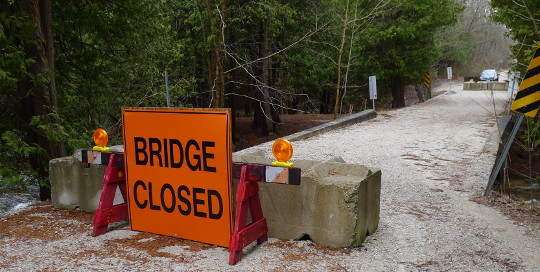Stephen Vance, Staff
Bridges 021 and 022 on the Holland-Sydenham Townline were front and centre again this week with residents asking council to explore options other than permanent closure, while Meaford’s Treasurer fielded numerous questions from council.
“Council needs to ensure that they are fully informed of all relevant information before they make a decision,” resident Ian Matthews told council at their April 24 meeting. “It is my respectful submission to you tonight that you do not have all the information, and for that reason you should not accept the EA (Environmental Assessment) in its present form.”
Matthews suggested that council needs to ask staff to go back to the drawing board and explore alternate bridge options as well as potential rehabilitation of the two single-lane bridges on the Holland-Sydenham Townline, which have been closed for more than a year. A recent EA study presented to council earlier this month identified permanent closure and removal of the structures as the preferred option to address the 70-year-old bridges that have been deemed unsafe for vehicle traffic.
On January 29, 2016, the Municipality of Meaford implemented the emergency closure of the bridges on the Holland-Sydenham Townline, due to the results of the Ontario Structural Inspection Manual (OSIM) and recommendations from Ainley and Associates Structural Engineers, who prepared last year’s State of the Infrastructure (SOTI) report for bridges in Meaford.
In September of 2016, the municipality hired consulting firm Planmac Engineering Inc. to complete a Municipal Class Environmental Assessment (MCEA) for the bridges, and in their report presented to council on April 10, they came to the same conclusion as the SOTI report a year earlier – that the bridges, which have been closed for more than a year, should be removed permanently, and that recommendation has area residents frustrated.
At the April 24 meeting, Meaford Treasurer Darcy Chapman walked council through a detailed presentation focused on the bridge issue, and he answered many questions from council who are struggling with trying to balance the needs of the residents who rely on the bridges, particularly area farmers for whom the detour routes and their hilly terrain are a challenge, and responsible management of municipal infrastructure with millions of dollars in rehabilitation and replacement funding required in the coming years.
In June of last year, a month after receiving the SOTI report, council adopted a strategy that will see the municipality spend nearly $80 million on bridges over the next 51 years, an average of $1.5 million per year.
Council was particularly interested in options that would allow the bridges to be reopened. Chapman noted that the request made of the EA study was to explore the best option to deal with the bridges, not to explore options to keep them open. He noted that council could choose to have another study conducted with a reformulated problem for the study to address. He cautioned however that council might not necessarily find more appealing options.
As was noted in the EA report presented to council on April 10, the estimated cost to replace the bridges ranges from a low of $750,000 to $1.2 million for a corrugated steel plate culvert structure, to as much as $2.4 million for a cast in place or precast concrete culvert structure.
Councillors asked why rehabilitation of the bridges wasn’t explored, and Chapman told council that the consultants had determined that rehabilitation of the bridges would only extend the life of the structures for an additional 10 to 15 years, and so it would not be a wise use of resources.
At the end of the discussion, Deputy Mayor Harley Greenfield informed council that he will bring a motion to council at a future meeting requesting that a second EA study is conducted. The estimated cost for the study is $50,000, and Greenfield suggested that, given that this is just the first of many bridge issues that will be coming before council in the coming years, it would be best to “do it right” on this file in order to be in a better position to make decisions on other bridges that have been identified as candidates for permanent closure.













